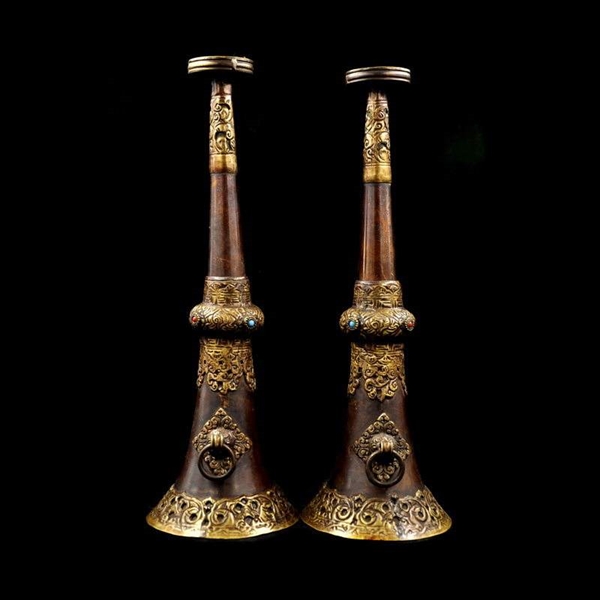Different Specifications of Tong Qin
Tongqin is also known as "mang tube", "copper winter", "copper hole", "big copper horn" and so on. "Tongqin" in Tibetan means a large size. The Mongolian people call it "Bili", and the Chinese call it a large tube, a long horn, and a small copper horn. It is a very important bass instrument in Lamaist bands. This musical instrument has a history of at least 700 years in Tibetan areas. It was first introduced to Inner Mongolia along with Lamaism in the second half of the 16th century.

There are two sizes of tongqin, the larger one is 260 cm to 350 cm in total length, and the smaller one is 130 cm to 220 cm in total length.
The Tongqin of the Jokhang Temple in Lhasa, Tibet, has a total length of 327.5 cm, the upper section is 95.8 cm long, the middle section is 88.5 cm long, the lower section is 12 8.5 cm long, the diameter of the mouthpiece is 4.5 cm, and the diameter of the bell mouth is 22.5 cm.
The Tongqin of Tashilhunpo Monastery in Shigatse, Tibet, has a total length of 275.2 cm and consists of three sections. The diameter of the mouth is 5 cm and the diameter of the bell mouth is 19.8 cm.
In the Sakya Monastery, Sakya County, Tibet, there is a very precious silver cymbal chin, with a total length of 346 cm, the upper section is 102 cm long, the middle section is 88 cm long, the lower section is 156 cm long, the mouth diameter is 5 cm, and the bell mouth is 5 cm in diameter. 28.5 cm in diameter.
The Xiaotong Qin in Labrang Monastery in Xiahe, Gansu Province, has a total length of 161.4 cm and consists of three sections. The diameter of the mouthpiece is 4.2 cm and the diameter of the bell mouth is 14 cm.
Qinghai Yushu Dangka Monastery has the shortest Xiaotong Qin, with a total length of 130.8 cm, the upper section is 58.8 cm, the lower section is 71.2 cm, the diameter of the mouthpiece is 4.6 cm, and the diameter of the bell mouth is 14 cm. Billy of the Lama Monastery in Inner Mongolia is relatively grown up. Some of them have a total length of 495 cm and a bell mouth diameter of 30 cm.
The big copper horn of the Uyghur people is also called the horn. The shape is similar to the suona. The total length is more than 3.3 meters. The whole body is made of steel. The upper end is a cup-shaped mouthpiece, and there is no sound hole on the tube. It is often used in folk music for national festivals, celebrations or welcoming guests. In recent years, it has also been used as a prop in singing and dancing performances for celebratory scenes.
 渝公网安备 50010702504639号
渝公网安备 50010702504639号